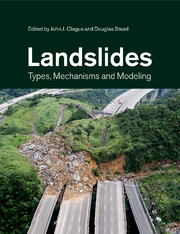Book contents
- Landslides
- Landslides
- Copyright page
- Contents
- Contributors
- Preface
- 1 Landslide hazard and risk
- 2 Landslides in the Earth system
- 3 Earthquake ground motion and patterns of seismically induced landsliding
- 4 Landslides at stratovolcanoes initiated by volcanic unrest
- 5 Mobility of long-runout rock avalanches
- 6 Rapid rock-slope failures
- 7 Risk assessments for debris flows
- 8 Landslides in quick clay
- 9 Controls on the distribution of major types of submarine landslides
- 10 Tsunami hazard assessment related to slope failures in coastal waters
- 11 Physical impacts of climate change on landslide occurrence and related adaptation
- 12 Landslides and geologic environments
- 13 Numerical modeling of rock-slope instability
- 14 Remote sensing techniques and landslides
- 15 Engineering geomorphology of landslides
- 16 Developments in landslide runout prediction
- 17 Models of the triggering of landslides during earthquakes
- 18 Slow rock-slope deformation
- 19 Landslide monitoring:
- 20 Groundwater in slopes
- 21 Soil slope stabilization
- 22 Rockfall characterization and modeling
- 23 The 2006 Eiger rockslide, European Alps
- 24 Randa:
- 25 Characterization and management of rockslide hazard at Turtle Mountain, Alberta, Canada
- 26 The Åknes rockslide, Norway
- 27 A seismometric approach for back-analyzing an unusual rockfall in the Apennines of Italy
- 28 Downie Slide, British Columbia, Canada
- 29 The 1963 Vaiont landslide, Italy
- 30 Hong Kong landslides
- 31 Landslides induced by the Wenchuan earthquake
- 32 Landslides on other planets
- Index
10 - Tsunami hazard assessment related to slope failures in coastal waters
Published online by Cambridge University Press: 05 May 2013
- Landslides
- Landslides
- Copyright page
- Contents
- Contributors
- Preface
- 1 Landslide hazard and risk
- 2 Landslides in the Earth system
- 3 Earthquake ground motion and patterns of seismically induced landsliding
- 4 Landslides at stratovolcanoes initiated by volcanic unrest
- 5 Mobility of long-runout rock avalanches
- 6 Rapid rock-slope failures
- 7 Risk assessments for debris flows
- 8 Landslides in quick clay
- 9 Controls on the distribution of major types of submarine landslides
- 10 Tsunami hazard assessment related to slope failures in coastal waters
- 11 Physical impacts of climate change on landslide occurrence and related adaptation
- 12 Landslides and geologic environments
- 13 Numerical modeling of rock-slope instability
- 14 Remote sensing techniques and landslides
- 15 Engineering geomorphology of landslides
- 16 Developments in landslide runout prediction
- 17 Models of the triggering of landslides during earthquakes
- 18 Slow rock-slope deformation
- 19 Landslide monitoring:
- 20 Groundwater in slopes
- 21 Soil slope stabilization
- 22 Rockfall characterization and modeling
- 23 The 2006 Eiger rockslide, European Alps
- 24 Randa:
- 25 Characterization and management of rockslide hazard at Turtle Mountain, Alberta, Canada
- 26 The Åknes rockslide, Norway
- 27 A seismometric approach for back-analyzing an unusual rockfall in the Apennines of Italy
- 28 Downie Slide, British Columbia, Canada
- 29 The 1963 Vaiont landslide, Italy
- 30 Hong Kong landslides
- 31 Landslides induced by the Wenchuan earthquake
- 32 Landslides on other planets
- Index
Summary
Although subaerial and subaqueous landslides have been responsible for many tsunamis in high-relief coastal areas around the world, routine assessments of these hazards are rarely undertaken. Assessment must draw on the expertise of geoscientists, engineers, and hydrodynamicists, and requires analyses of both the landslide and the resulting waves. Landslide tsunami assessments aim to determine:
occurrences of past events
likelihood of future occurrences
magnitudes of past events
locations experiencing greatest impact
conditions and triggers that led to failure
wave characteristics and coastal run-up.
Key assessment considerations include the geologic evidence of past failures, both subaerial and subaqueous, and the written or oral history of past events. These can aid in determining whether further assessment studies are warranted. The general paucity of observations of past events, however, makes empirical assessment difficult. As a consequence, physical and numerical modeling are critical tools in characterizing the phenomena. Because modern numerical models are fast to run and relatively inexpensive, they are now widely used for specific case studies. Much can be learned before failures occur in areas prone to tsunamigenic landslides. Hydrodynamic modeling, combined with geologic and geotechnical evidence, can be used to assess the tsunamigenic potential of landslides. Although definitive estimates of the frequency of occurrence and magnitude of tsunamigenic events are difficult to make, analyses can place valuable constraints on the siting and design of coastal facilities.
- Type
- Chapter
- Information
- LandslidesTypes, Mechanisms and Modeling, pp. 108 - 120Publisher: Cambridge University PressPrint publication year: 2012
- 12
- Cited by



